#fungus id help
Text
look at this insane mold i found on the cieling of my work place


also the mushroom is so funny. anyways i tried to ID but i have no idea how to go about IDing molds. any help or a point in the right direction is appreciated!
#mold id#fungus id#mushroom id#mold#mushroom#mushrooms#molds#mold id help#fungus id help#mushroom id help#!!!#pix#fungi
17 notes
·
View notes
Text




Mushrooms around the cabin on my camping trip!
Taken with Canon EOS 70D in New Hampshire
#nature photography#nature photographer#mushrooms#mushroom#fungi#fungus#mycology#if anyone can help id them I would appreciate!#new hampshire#new england#nature#plants#jinx_flix#canon photographer#canon EOS70D#macro photography
9 notes
·
View notes
Text


check out this massive big guy i found on a tree today. my book says he might be a pūtawa but it looks darker on top than the one in my book so maybe its a relative
#if any of u fungus folk know what this is I'd love an ID!!!#i don't know the tree it was growing on sorry. was rushing to get a bus and didnt think to ID the tree lmao that wouldve helped
9 notes
·
View notes
Text
I find it funny that half our iNat IDs are stuff like us going "you can tell from the lack of checkering on the wing fringe that this is actually P. icarus, not P. bellargus" while the other half are us going through unknown observations and going "well that sure is a plant. hopefully someone who knows plants will see it after I add this ID"
#personal#thoughts#🍬 post#inaturalist#there are thousands of unknowns on there and I think most are just from people not knowing how to use the site#because sometimes they'll put ''this is [species]'' or ''is this [species] or [other species]?'' in the notes/description section#but not add an actual ID so it's not searchable and therefore nobody confirms it because it's just in the huge unknown pile#so we've kind of made it a hobby to go through those and at least put them in broad categories so other people see them#but god it must be confusing/frustrating for the people posting them to get an ID that's just ''plant'' or ''fungus'' or whatever#like sorry my dude I know this doesn't look helpful but I'm trying to make sure your stuff actually gets seen by anyone#also going through the unknowns means seeing wildlife photos from around the world which is fun#and then once people ID them we get to find out about a bunch of species from different places
13 notes
·
View notes
Text
Can’t sleep. Thinking about fungi.
#and rocks#I have thoughts#rare occurrence ik#I’m excited this week I’m going to go have a look. a hint if you will. for any new growths#I’d like to start taking spore prints!#it would help with my id book and also make for cool images for the ‘language of fungi’#found one the other day that at first glance looked like a turkey tail but was far too chunky#and as for rocks well.#I wanna go rock hunting with someone#oh to wade into a rock pool#while fun solitary activities. oh to go rock hunting and mushroom gathering with a friend#I am - most of the time - thinking about fungi#or ships#ships and fungi#need to find that short story where a mysterious fungus takes over an entire ship and idk. asphyxiates the crew???#what tf was that story???#anyways
8 notes
·
View notes
Text
ok I know I'm already in the process of writing an extremely long video game retelling/au where the protag is a nonhuman who gets suddenly and unwillingly put in a situation where they have to pass as A Normal Guy by the threat of harm/death while also being put into a role where they're the Only One capable of saving the world. but what if I started a DIFFERENT one too
#howling#specifically I've been tossing around this bg3 scenario#where the dark urge and some random druid (specifically a circle of spores druid) are on the nautaloid when it gets attacked#the druid dies badly and the symbiotic entity they're carrying gets kicked out of their host#and so it attaches itself to the nearest living thing as like a self-preservation measure#which happens to be a VERY lobotomized dark urge#as in 'practically brain dead'#and so the entity is now stuck in a new body they have to figure out how to pilot COMPLETELY ALONE#other than the extremely unhelpful passenger already in this fucker's brain (the tadpole)#and still has the dark urge instincts and. well. urges. but they have even LESS access to memories than normal durge has#so it now has to both convince their friends AND their enemies that yes they definitely are a humanoid guy with a past#and not a cloud of sentient fungus puppeting a sort-of corpse#idk I just really love the idea of everyone being like 'wow it's so fucked up that we have parasites in our brains threatening to take over#and this guy is just like. oh hahah yeah (<- is a parasite who took over a guys brain)#anyways. id still be writing history offers preservation but id just ALSO be doing this too#like. idk maybe it'll help my writers block if I can mix shit up a bit#use scrapped ideas for one that might work better for the other y'know#this also isn't like. a guaranteed thing btw. I've just been rotating this concept in my brain for a bit now
6 notes
·
View notes
Text
The only algorithm I love and worship is the peer-reviewed and educational iNaturalist
#Google can go f—- itself#Instagram? never heard of it#but you help me ID this bug or fungus and buddy we’re pals
6 notes
·
View notes
Text


85% sure this is a pleated inkcap? Not positive, but it sure was in my garden this morning.
1 note
·
View note
Text

I have THE biggest, BEST news EVER--
I GOT A BOOK CONTRACT!!!!!!!!
I am exceptionally pleased to announce that I have just signed a contract with Ten Speed Press (a division of Penguin Random House) to publish...
The Everyday Naturalist: How to Identify Animals, Plants, and Fungi Wherever You Go!
It is slated for publication in early Summer 2025, and will be written for anyone who wants to be able to identify the living beings around them regardless of educational level or experience. A HUGE thank you to my literary agent Jane Dystel of Dystel, Goderich & Bourret LLC, and my editor at Ten Speed Press, Julie Bennett!
This isn't just another field guide--it's a how-to book on nature identification that helps you go from "I have no idea what this animal/plant/fungus is and I don't know where to start" to "Aha! I know how to figure out what species I'm looking at/hearing!" Those familiar with my nature ID classes know that I emphasize skills and tools accessible to everyday people. Whether you're birdwatching, foraging, or just enjoying the nature around you, my goal is to help you be more confident in figuring out what living beings you encounter wherever you go--and not just in the Pacific Northwest.
The Everyday Naturalist will not only explain what traits you need to pay attention to like color, size, shape, location, etc. and how to use them to differentiate among similar species, but will also detail how and when to use tools like apps, field guides, and more. (And given the current kerfuffle about A I generated foraging books, I will of course include information on how to determine the veracity of a given book or other resource.) And my editor and I have already been discussing some great additions to the book that will make it even more user-friendly!
Are you excited about this? I certainly am! I wanted to wait until the pixels were dry on the contract before going public with this (though my newsletter subscribers got to hear about it last month, lucky them!) It still doesn't feel real, but I'm already working on the manuscript so it'll sink in soon enough.
I will, of course, keep you all apprised of my progress because this project is going to be a big part of my life over the next several months as I write and edit and write and edit and wash, rinse, repeat. So keep your eyes on this space for updates (and feel free to add yourself to my monthly email newsletter here, too!)
#nature#nature identification#animals#plants#fungi#field guide#mushrooms#foraging#birding#birdwatching#scicomm#science communication#books#nonfiction books#publishing#wildlife#science#biology#botany#mycology
986 notes
·
View notes
Text
So, you guys know Merlin Sheldrake, who went viral for publishing his massive book about mushrooms, using a copy to grow mushrooms, and then eating the mushrooms? Well, I got a copy of his book, Entangled Life, on one of my library apps recently. I figured it might help with the novel about Davzda and the hallucinogenic mushrooms that are used in making it.
It's engaging, but it's also very dense and meandered a bit, so I didn't end up finishing it. It's a bit like being trapped in a room with the most charismatic person ever to have a deeply neurodiverse hyperfixation on fungi. But also it contains random gems such as:

[ID: Text reading "A friend of mine, the philosopher and magician David Abram, used to be the house magician at Alice's Restaurant in Massacusetts (made famous by the Arlo Guthrie song)."]
That's so much to put into one sentence, Mr. Sheldrake.
And he drops a bunch of new genders (perhaps new sexualities?) so you all have fun:

[ID: Text reading "Some fungi have tens of thousands of mating types, approximately equivalent to our sexes (the record holder is the split gill fungus, Schizophyllum commune, which has more than 23,000 mating types, each of which is sexually compatible with nearly every one of the others.)"]
Amusingly for me mainly because of the Shivadhverse, he also manages to namedrop both a Theophile
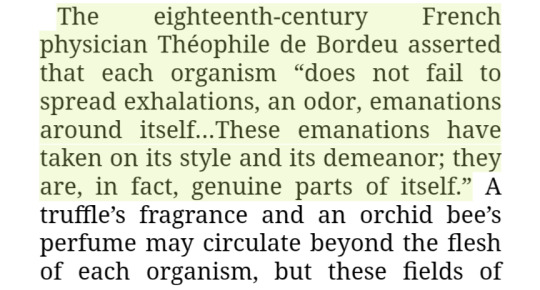
and a LeFevre (Simon the chef's last name)

in the first hundred pages.
Anyway, fun book to drop into and out of, especially as an ebook; it feels like it might be a bit much to handle in person unless you are a fellow passionate mycologist.
[ID: Last two images feature quotes by the eighteenth century French physician Theophile de Bordeu, speaking on the scent of living organisms, and a truffle scientist and cultivator in Oregon named Charles Lefevre, who works with Perigord black truffles.]
256 notes
·
View notes
Note
Hey, i really like your blog. It brings a smile to my face whenever i see your posts, even if im having a hard time. I was wondering if you could possibly identify this little lady?


She showed up one day in between my plants about three weeks ago, i was really excited, hoping she would eat the fungus gnats around them and brought all my plants to her corner so she could feed. Later on she moved her web slightly to the left cause sadly she had built the first one onto a drawer and i accidentally broke it even tho i was very carefull :"(( i found some dead bugs that died in the windowsill you know how it is, and picked them with tweezers and carefully dropped them onto the net, hoping she was eating enough cause i never saw anything trapped in her web, she wrapped them quickly and ate them in minutes i was so proud, tho im unsure if its unsafe for her that i feed her allready dead bugs? Im worried, she suddenly stopped eating and then disappeared for a few days i was really worried that she left cause there wasn't enough food or that my home is perhaps not good for her? But now she is suddenly back to the window and she looks much larger than she used to be! Tho i dont think her abdomen grew, but her legs deffenetly got longer, and the head too! She has her net on the window by my comfy chair i sit all day watching anime in and it makes me happy to look over at her, i really wonder what type of spider she is and how i could help her be comfortable and grow big and strong in my house.

Thats her belly
Sorry for the super long ask i really wanted to tell her story.
I really love her, i used to be afraid of spiders but ive really grown fond and interessted on them, no creature escapes my passion and awe for nature now, mabe some parasites, those are ahdiwhisheiauaiabsj ":(.
Anyways i think we share a love for creatures and i admire your knowledge <3
NORWEGIAN SPIDER ID:
Hello yes, thank you for you kind words, and thank you for sharing the story with us.
I particularly love having spiders near my home. I remember seeing one of these in the garden, as a child, and I loved watching it on its web.
This is a European Garden Spider aka Cross Orbweaver (Araneus diadematus), family Araneidae.
This species is common across Europe and NE and NW North America.
66 notes
·
View notes
Text
Dry Beast Monday: chinchillas
For over a year now I've been doing weekly Wet Beast Wednesday posts where I do a deep dive on some aquatic animal, and you know what? I'm tired of it! This is now a dry beast blog!* And where better to start than an animal that can literally die if it gets wet? Beasts can't get much dryer than that. So strap in for the first Dry Beast Monday... Dmonday?... Drunday? Whatever, it's the chinchilla.
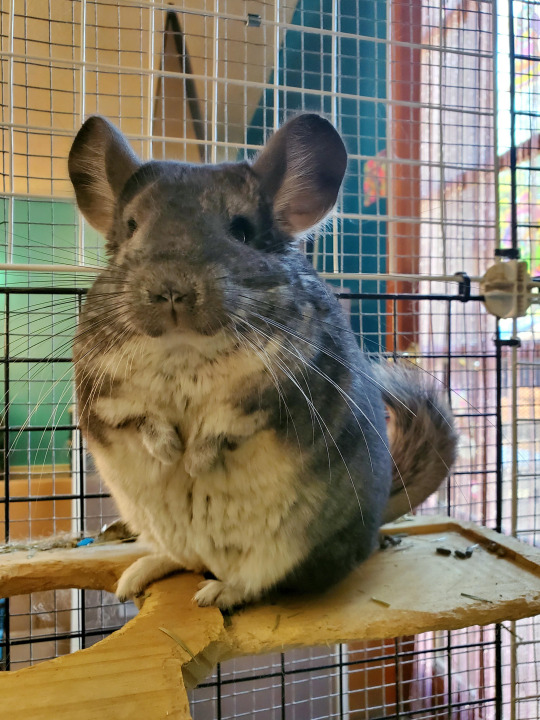
(Image: a pet chinchilla in a cage, standing upright on a wood platform that has been heavily chewed. It is a rotund mammal with a similar body plan to rabbits, featuring a large head distinct from a round body. Its hind paws are larger than the forepaws and have more distinct toes. Its eyes are almost completely black and it has a flat nose with very long whiskers. The ears are large, rounded, and mostly furless. The tail is bristly hair like a squirrel's and is curled up. Most of its fur is a dark grey but the fur on its underside is white. End ID)
Chinchillas are rodents (the best mammals, fight me) that are members of the family Chinchilladae along with the viscachas. There are two living species of chinchilla: the long-tailed chinchilla (Chinchilla lanigera) and the short-tailed chinchilla (Chinchilla chinchilla, formerly Chinchilla brevicaudata). The two species can produce sterile hybrid offspring. Domesticated chinchillas are descended from the long-tailed chinchilla. All chinchillas are medium-sized rodents with powerful back legs, long whiskers, large ears, and extremely dense fur. In comparison, the short-tailed chinchilla is larger and has a shorter tail, thicker and less distinct neck and shoulders, and smaller ears. The most famous feature of chinchillas is their fur. At about 20,000 hairs per square centimeter, chinchillas have the second densest fur of any mammal, second only to sea otters. Each hair follicle grows up to 50 hairs, compared to human follicles, which only grow 1. The fur is famous for being incredibly soft, often described as velvety. If you've never felt a chinchilla its really hard to describe just how soft they are. The fur is so dense because Chinchillas live in the highlands of the Andes mountains where it gets very cold. The fur is used for insulation and even with it being so thick, chinchillas still need to bask in the sun to warm themselves up. The fur is actually the reason why chinchillas can't get wet. Their fur is so dense that wanter can't evaporate easily, instead remaining around long enough for fungus to start growing in the fur. This can lead to a lot of different skin conditions and infections that can be lethal. When chinchillas bathe, they take dust baths. By rolling around in volcanic ash, the can work the ash into their fur, where it absorbs oils, moisture, and other contaminants. This keeps the fur clean and healthy. Domestic chinchillas need specially made dust for their baths. It cannot be substituted with sand or other materials. Chinchillas can release chunks of their fur in order to escape from predators, leaving the predator holding nothing but a tuft of hair while the chinchilla runs away. This is called fur drop and in domestic chinchillas it can be a sign of mishandling or stress. Wild chinchillas have grey fur, but domestic breeds have been bread to have other colors of fur, including white and black. Chinchillas can't sweat, which isn't a problem in their natural habitat, but is for domestic chinchillas. The only way for them to cool down is to expose their ears (which are hairless and heavily vascularized) to wind. Chinchillas in temperatures at or above 26 degrees C (80 F) are at risk of having heat strokes. Daytime in the Andes can exceed those temperatures, so chinchillas hide in burrows during the day. Chinchillas are very skilled at jumping, able to leap up to 1.8 meters (6 ft). Their hind legs are longer than the forelegs and provide propulsion when walking or jumping. The toes has fleshy pads called papillae that help them grip onto surfaces. Chinchillas live in arid, rocky conditions and are skilled at leaping between rocks. The tails act like rudders, providing stability and direction when leaping. The front feet are capable of gripping and picking up objects. Females tend to be larger than the males, but there is otherwise little visual difference between the sexes. Wild short-tailed chinchillas can reach 38 cm (including tail) and 800 grams while wild long-tailed chinchillas can reach 26 cm (including tail) and 450 grams. Domestic chinchillas can get up to twice the size of their wild relatives.

(Image: a wild long-tailed chinchilla sitting under a rock. Its body plan is the same as the pet chinchilla above, but its fur is a lighter grey End ID)

(Image: a short-tailed chinchilla in captivity. It has a less distinct neck than the long-tailed chinchilla, making it look like its head merges with the body. Its tail is shorter than that of the long-tailed chinchilla, making up about 1/5th of its length as compared to the long-tailed chinchilla's 1/3rd. End ID)
Chinchillas are social animals that live in colonies called herds that can reach up to 100 members. Females dominate the herds and can be aggressive toward each other, though physical fights are rare. The herd cooperates when finding food, always having at least one member acting as a lookout to spot predators while the rest feed. They communicate vocally, with 10 types of vocalizations on record for. Social behaviors include grooming, playing, and friendly nibbling of each other's ears. Pet chinchillas should never be kept alone. They should be in same-sex groups of at least 2. Chinchillas are crepuscular, active mostly at dawn and dusk. During the day and night, they are usually found hiding in burrows or crevices between rocks, where they can avoid predators and high or low temperatures. They are primarily herbivores, but will supplement their diets with insects and other bugs. Most of their diet consists of grasses, seeds, and succulents and cacti. Wild ones almost never drink water, instead getting all of their hydration from their food. Chinchilla digestive systems are fairly specialized to their food. Domestic chinchillas need special-formulated food and can only have wooden chew toys form certain species of wood. Fresh or dried fruit is good for a treat, but should not be a regular part of their diet as they have a lot of sugar. As with all rodents, the incisors grow continuously through the animal's entire life and need to be worn down by chewing on things.
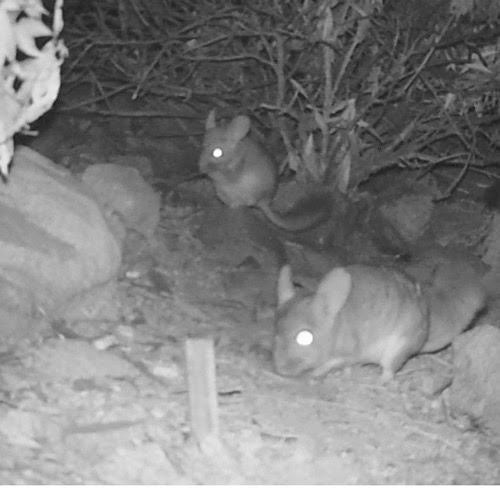
It is surprisingly hard to find good-quality images of wild chinchillas. Most of the time when you search for wild chinchilla pictures what you get are either domestic chinchillas or viscachas.
(Image: a trail-cam shot of two wild long-tailed chinchillas. The photo is i black-and-white. One is in the foreground on all fours while another is on its hind feet in the background, standing on a rock. The terrain is rocky and the chinchillas are next to a shrub. The camera's light makes their eyes appear to glow white. End ID)
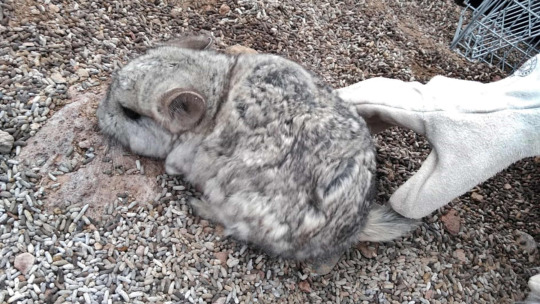
(Image: a wild short-tailed chinchilla that is part of a relocation effort. Its fur is light grey with darker patches. A gloved human hand is reaching in from the right side of the image. End ID)
Male chinchillas appear to be fertile year-round, but females only enter estrus during the winter, from May to November in their natural habitat. Gestation takes around 120 days in both species and both species typically have two litters a year (a low rate for a small mammal). Offspring (called kits) are born well-developed, with fur and open eyes, and can run as soon as they are born. They nurse for 6-8 weeks before being weaned. 1-6 kits are born at a time, with 2 being the usual number. Chinchillas are monogamous, mating for life. Either partner can initiate mating, which they do so with hair-pulling. Unusually for rodents, male chinchillas do provide care for their offspring. Members of the same herd will help each other with parenting. Female chinchillas have been known to adopt the kits of other females who can't nurse due to health issues. Females are usually dominant due to their size. Chinchillas become sexually mature at around 8 months. In the wild they can live for 10 years, which is doubled in captivity.
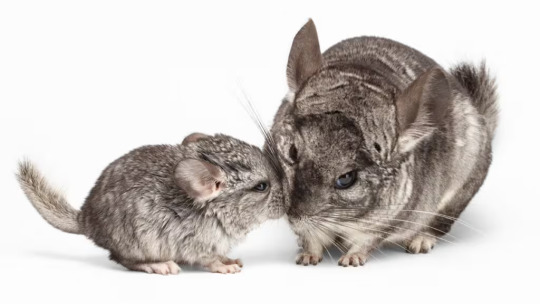
(Image: an adult domestic chinchilla with a juvenile. The juvenile is smaller than the adult, with proportionally larger head and limbs and proportionally smaller tail. The two of them are nuzzling their snouts together. End ID)
The name chinchilla comes from the Chincha people of the Andes, who hunted chinchillas for their fur and meat. This hunting increased vastly after European colonization of South America. Between hunting and trapping, both species of chinchilla were brought to near extinction and vastly reduced their native range. Both species are now only found in Chile and have been granted legal protection. The IUCN switched their classifications between Vulnerable, Endangered, and Critically Endangered for a while. As of 2016, both species are classified as Endangered, upgraded from Critically Endangered as their populations have seen some improvement. Poaching, both for fur and capture for sale as pets, is still a large threat to wild chinchillas. Their close cousins, the viscachas, are doing much better as they were not hit as hard by the fur trade. The domestication of the long-tailed chinchilla is thanks to Mathias F. Chapman, an engineer who became fascinated with the animals after meeting a native person who was trying to sell one. He ended up getting permission from the government of Chile to capture several and import them to the USA. It took him 3 years to catch enough that he considered suitable for breeding, 11 in total. He then spend over a year gradually bringing them down from the highlands to sea level, giving them plenty of time to acclimate to the lower altitude. Once in the USA, Chapman started breeding his chinchillas in a farm in California, though he had to deal with medical problems and a thief stealing half of his stock. Eventually, though, his experiment paid off. The vast majority of all domesticated chinchillas today are descended from those original 11, brought to the states in 1923. Chinchillas today are raised in captivity for their fur, for use as laboratory animals, and as pets. While both species are raised in captivity for fur, the domesticated chinchilla is descended from the long-tailed chinchilla and short-tailed chinchillas apparently do not make as good pets.
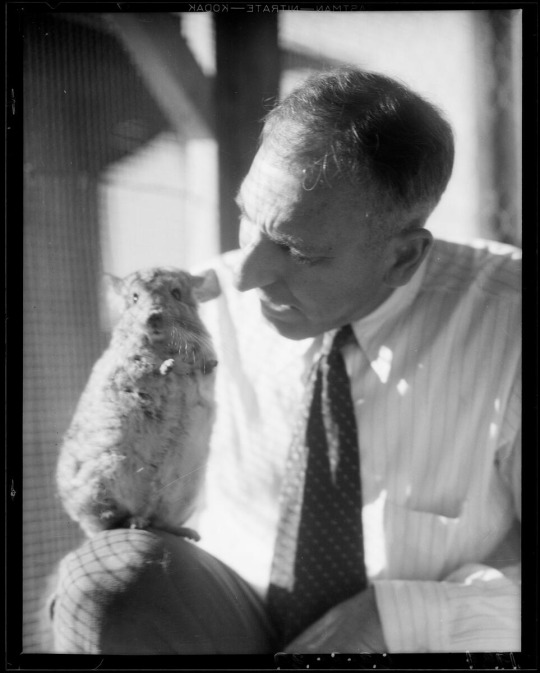
(Image: a black-and-white photo of Mathias F. Chapman, a white man with a large nose wearing a shirt and tie. A chinchilla is standing on his leg and looking at the camera while he looks at the chinchilla. End ID)
* April Fools
#april fool's day#the animal facts are real#dry beasts#dry beast monday#wet beast wednesday#chinchilla#long tailed chinchilla#short tailed chinchilla#domesticated chinchilla#rodent#mammal#biology#ecology#zoology#animal facts#informative#fur trade
117 notes
·
View notes
Photo

[Image description: a tiny white insect or insect-like creature with six legs and two antennae, sitting on the wood-like fungus it is eating. The creature is segmented and appears soft and almost worm-like, and has two black compound eyes or clusters of eyes on the sides of its head. It has two red spots on its back and its body and antennae are covered in bristles. The photo is blurry at the edges. End ID.}
@spectruminterests submitted: I found this insect (hexapod?) on a polypore fungus growing on a dead tree. I took it and part of the fungus it was eating to my college entomology class and looked at it and took pictures under a microscope. If you can help ID it that would be great, but no pressure since neither I nor my TA could figure it out. More pictures below:
Hi there! Thank you for letting me know your location in your IM. This is a cool little dude. Here are some extra photos the submitter sent that didn’t attach to the original submission:

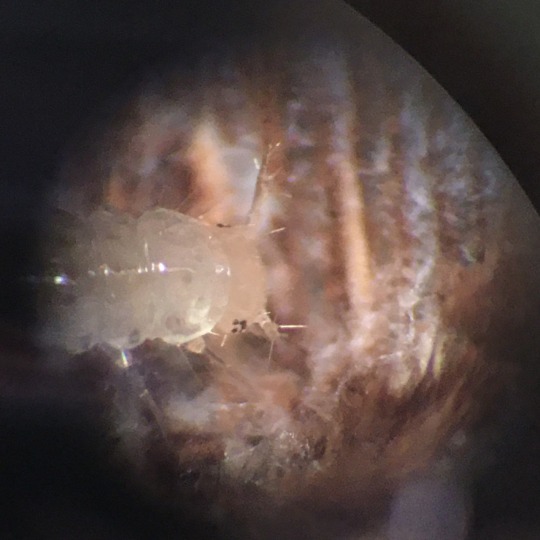
Ok I think this fella is a rove beetle larva - probably one of the crablike rove beetles in the subfamily Tachyporinae. At least, that’s the closest match I could find, and it makes sense, as they are fungus-eaters.
Here are some photos of similar larvae in the same subfamily. No exact matches, but there aren’t many positively IDed photos of these guys available it seems! Here’s another similar one from bugguide.
Either way, very interesting find! Thanks for sharing!
147 notes
·
View notes
Text
Things that some people new to foraging fungi do that are not good, annoying, or just plain silly:
- Posting on places like reddit or Facebook for ID of a mushroom that their pet or child ate. Don’t do that. If you think your pet or child has been poisoned, go to a vet or doctor and bring the fungus with you, or at the very least call a poisons hotline. Most national poisons hotlines have people who are good at identifying fungi since this kind of thing happens all the time
- Going out and harvesting every single edible mushroom you can find and coming back with literal bags full. I am pretty avid about foraged fungi, but I have never been able to get through more than a kilo of foraged fungi before they go bad unless I am eating heavily mushroom-based meals every day, or if I spend basically two days dehydrating and processing them. When you take more than you could possibly use or share, you’re just leaving nothing for anyone else and wasting something that other people or wildlife could have eaten.
- Overharvesting in general. Yes, I know that picking mushrooms doesn’t harm the mycelium underground and all that. However, mushrooms are what spreads the spores around and makes the possibility of more colonies starting elsewhere. If you pick every single mushroom you can see, then you are damaging the ability for that colony to propagate. This is especially so for fungi that you are meant to harvest before they mature like certain boletes and shaggy inkcaps.
- Asking for help IDing after picking or damaging a fungus. You can take photos while it’s in nature just as easily as if it was in your living room. If you don’t want to get dirty kneeling down to take photos of the undersides of gills, maybe consider a different hobby. I have seen SO many people post photos on fungi groups when they are handling it in their house without gloves on. I know you can’t get poisoned just from touching a mushroom, but it’s incredibly easy to touch your face, mouth, or eyes absentmindedly, or the faces of other people you are responsible for. The worst example of this I remember seeing is the fungi on someone’s living room table with their very young child within grabbing distance of the mushroom (in this case, it was a deathcap). You don’t want to end up like point one of this list.
- Posting ghost orchids. This is less serious and more just my pet peeve, but COME ON. It looks like a FLOWER.
- On that note, asking for an ID without bothering to do a single search yourself. It will stop people like me mocking you for posting photos of flowers in a mycology group thinking they are mushrooms.
I see all of these constantly.
#mini rant#I can only see so many photos of people overharvesting chanterelles before I go insane#mycology#fungi#foraging
129 notes
·
View notes
Text
Thinking so hard abt a Magpod (more TMA but TMagP DEFINITELY fits) x Home Safety Hotline cross,,,
Jon 2 days into his job going head-in-hands once he gains access to the ‘confidential pests’ ((he’d STILL keep up his skeptic act too))
Honestly wonder what Jane prentiss would be,,, i feel like Reanimated’s description matches her to a T “may carry parasites, violent to homeowners, incredibly adept at /hiding and waiting for vulnerable moments/“
His Season 2 paranoia does NOT trust Martin’s tea to not attract tea sprites, he’d throw a FIT
Jon would see the catalogue as a reverse hitlist of all the mfs after him
Oh god,,, mirror nymph’d Sasha?
Season 3 The Admiral gets unicorn fungus and Jon is awkwardly trying to ignore it,, also Jon regularly checking if Admiral gets pooka’d :(
Oooo Jon encountering a dream weaver instead of Mr. Spider?
Not sure if i’d prefer a (probably expanded) HSH-only catalogue, a Smirke-only catalogue (of avatars ig? And/or the non-human phenomena?), or maybe a mix of both?
But also,,,, while i mainly first thought abt this with archives, protocol is kinda just BUILT for HSH aint it? Got the whole set-up already: get unsettling recount of experience (from old ass PC, would be fun with a Freddie’s haunted ass giving Sam early-access to info he wasnt meant to have,,), categorize incident report into your spooky filing system. Would just change it to a hotline and actually HELP them bitches. (The helping advice is “consider therapy”)
If i had any free time (or yknow, done any of my own writing past 1 middle school assignment,,, guess i could draw but thinking of drawing a comic makes me wanna invert) to actually develop this i’d be so powerful, id be so fucking annoying about it
#tma#tmagp#magpod#the magnus archives#the magnus protocol#jonathan sims#samama khalid#home safety hotline#hsh#tma au#im going crazy#magnus hotline
32 notes
·
View notes
Text
mutual 1: the new fnaf movie was great but the matpat mpreg scene was a bit weird
mutual 2: someone help me id this fungus I found in my house
mutual 8: Dr eggman was so bpd when you thjnk about it
mutual 3: mutual 2 that's fucking asbestos
mutual 4: the new fnaf movie was great but they should've added the matpat mpreg scene
mutual 5: My touys
mutual 6: Saul Goodman's so trans coded. to me. if you care.
mutual 2: we don't (I want you.)
mutual 4: responding to the most insane anon hate ever you just hate my whimsy :3
mutual 8: can you believe mutual 6 got fucking doxxed over that
mutual 9: who wants to see this deer carcass I just found
mutual 7: what if we kissed next to the deer carcass😳
mutual 10: god I fucking hate jerma
mutual 5: My tou ys
mutual 9: #tw gore #tw animal death #tw blood #tw horror #viscera #me and who #spinal fluid #evisceration
#this is reaching mutual 9s no hate to yall bc same but any time this happens to me ive had hit posts on the coffin kisser side of tumblr#🎀gutz.txt🎀
79 notes
·
View notes